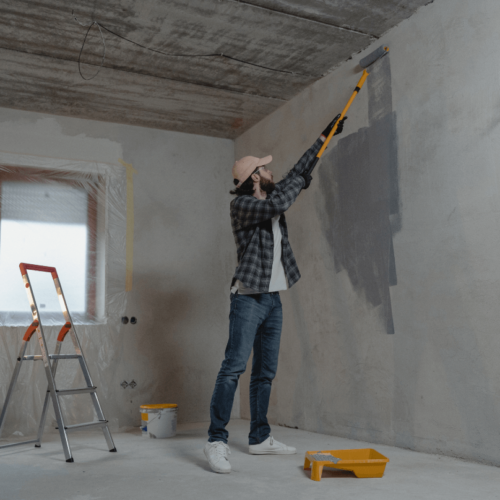What's Behind That Fresh Paint? Signs of a Covered-Up Problem

A fresh coat of paint might look appealing to potential buyers, but as any experienced home inspector will tell you, it can also be a red flag. Strategic painting right before listing a home sometimes masks serious underlying problems that could cost thousands to repair.
Why Sellers Paint Before Listing
Not all fresh paint is suspicious. Many sellers genuinely want to present their home in the best possible light, and fresh paint can:
- Make rooms look brighter and more spacious
- Update outdated color schemes
- Create a move-in-ready appearance
- Increase the home's market appeal
However, when paint is applied hastily or strategically to specific areas, it warrants closer inspection. Experienced buyers and inspectors know to look beyond the surface.
Red Flags to Watch For
Selective Painting
When only certain walls, rooms, or sections have been freshly painted while others show normal wear, ask yourself why. Selective painting often targets problem areas rather than providing overall aesthetic improvement.
Thick or Textured Paint Application
Unusually thick paint or heavy texture can hide cracks, holes, or water damage. Run your hand along painted surfaces—you should feel smooth, even coverage. Bumps, ridges, or inconsistent texture may indicate concealed damage.
Paint Over Wallpaper
Painting over wallpaper is often a shortcut that can hide moisture damage, mold, or wall defects. Look for telltale signs like visible seam lines, bubbling, or areas where the underlying wallpaper pattern shows through.
Different Paint Sheens
If freshly painted areas have a different sheen (gloss level) than surrounding paint, it may indicate spot repairs. Different paint types are sometimes used to better conceal specific types of damage.
Inspection Tip
Use a flashlight held at an angle to the wall surface. This side-lighting technique reveals surface irregularities, patch work, and texture differences that might indicate covered-up damage.
Common Problems Hidden by Paint
Water Damage and Stains
Water stains from roof leaks, plumbing issues, or flooding are often the first targets for cover-up paint jobs. However, water damage rarely stays hidden for long:
- Stains may bleed through even multiple coats of paint
- Areas may feel soft or spongy when pressed
- Musty odors may persist despite fresh paint
- Paint may bubble or peel in affected areas
Cracks and Structural Issues
Settlement cracks, impact damage, and structural movement create visible damage that sellers may attempt to hide with strategic painting:
- Cracks often reappear through paint over time
- Thick texture paint may be used to camouflage crack patterns
- Corner joints and ceiling lines are common crack locations
- Caulk lines painted over may indicate recent crack repairs
Mold and Mildew
In Florida's humid climate, mold and mildew are persistent problems. Paint can temporarily hide these issues, but they typically return:
- Dark spots may show through paint within weeks or months
- Musty odors often persist despite surface treatment
- Bathroom and basement areas are especially susceptible
- Regular paint won't solve underlying moisture problems
Holes and Impact Damage
Holes from nails, screws, or impact damage are commonly filled and painted over. While minor holes are normal, extensive patching may indicate:
- Removal of fixtures hiding electrical or plumbing problems
- Impact damage from furniture or accidents
- Previous amateur repair attempts
- Insect or rodent damage that required patching
How to Investigate Suspicious Paint
Professional Inspection Techniques
Experienced inspectors use several methods to see beyond fresh paint:
- • Moisture meters: Detect hidden water damage behind paint
- • Thermal imaging: Reveals temperature differences indicating problems
- • Infrared cameras: Show moisture patterns invisible to the naked eye
- • Magnifying inspection: Close examination of paint texture and application
What Buyers Can Do
While buyers shouldn't damage property during viewing, they can:
- Ask direct questions: When was the painting done and why?
- Look at listing photos: Compare current paint to earlier photos
- Check all areas: Don't let fresh paint distract from thorough examination
- Hire a professional: Experienced inspectors know what to look for
- Request disclosures: Ask about any water damage or repairs
Florida-Specific Concerns
Florida's climate creates unique challenges that fresh paint often attempts to hide:
Hurricane and Storm Damage
Florida homes regularly face severe weather that can cause hidden damage often painted over for quick sales. Wind-driven rain can penetrate walls and windows, creating damage that may not be immediately visible.
Humidity-Related Issues
High humidity causes ongoing moisture problems that paint alone cannot fix. Condensation issues, poor ventilation, and moisture intrusion create persistent problems that return even after painting.
Termite and Pest Damage
Florida's active termite population can cause significant structural damage. Fresh paint may hide termite tubes, wood damage, or areas where pest treatments have left stains or damage.
The Importance of Professional Inspection
While fresh paint isn't always suspicious, it should never prevent a thorough professional inspection. Experienced inspectors have the tools and knowledge to:
- Detect moisture and water damage behind painted surfaces
- Identify structural issues masked by cosmetic improvements
- Recognize patterns that suggest covered-up problems
- Use specialized equipment to see beyond surface appearance
- Provide documentation for insurance and warranty purposes
Red Flags vs. Normal Maintenance
🚩 Suspicious Signs
- • Paint only in specific problem-prone areas
- • Unusually thick or textured application
- • Different paint types or sheens
- • Fresh paint with persistent odors
- • Painting done immediately before listing
- • Reluctance to discuss recent repairs
✅ Normal Maintenance
- • Consistent paint throughout the home
- • Even, professional application
- • Neutral colors for broad appeal
- • Part of overall home preparation
- • Seller openly discusses improvements
- • Documentation of professional work
Protecting Yourself as a Buyer
The key to avoiding painted-over problems is thorough due diligence:
- Never waive inspections: Even in competitive markets, professional inspection is crucial
- Ask for maintenance records: Request documentation of all recent repairs and improvements
- Research the property: Check for insurance claims, permit records, and previous listings
- Trust your instincts: If something feels off, investigate further
- Consider specialized inspections: Mold, structural, or moisture inspections may be warranted
The Bottom Line
Fresh paint isn't inherently problematic, but it should never be the end of your investigation. In Florida's challenging climate, underlying moisture, structural, and pest issues are common and can be expensive to repair.
A thorough professional inspection by an experienced inspector familiar with Florida's unique challenges is your best protection against costly surprises. Don't let a fresh coat of paint blind you to potential problems that could affect your investment for years to come.
Suspicious About Fresh Paint in Your Potential Home?
Our experienced inspectors know how to look beyond cosmetic improvements to identify hidden problems that could cost you thousands later.
